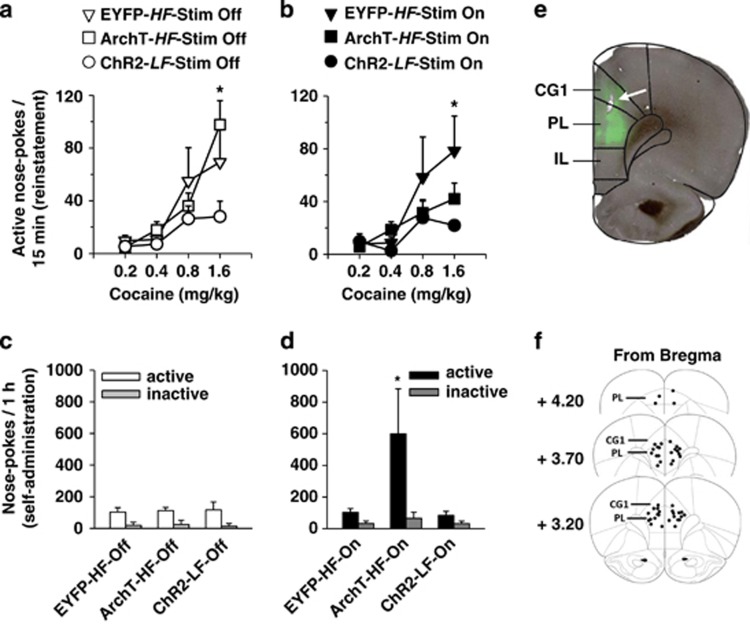Figure 6.
Effect of optical manipulation of the PL on cocaine-induced reinstatement (a, b) and cocaine self-administration (c, d). (a, b) Cocaine-induced reinstatement in EYFP, ChR2 and ArchT rats. (a) Reinstatement of extinguished behavior measured by active nose-pokes in response to non-contingent infusions of increasing doses of cocaine in absence of optical stimulation (control condition: Stim Off). EYFP and ArchT ((both High frequency (HF)) showed a comparable reinstatement that was higher as compared with ChR2 rats (Low frequency (LF)). *p<0.05 ArchT and EYFP as compared with ChR2. (b) Same as in panel a but during optical stimulation (Stim On). Inactivation of the PL in ArchT rats significantly decreased reinstatement while its activation in ChR2 rats was without effect. Optical stimulation did not alter the behavior of the EYFP rats. *p<0.05 EYFP as compared with ArchT and ChR2. (c, d) Cocaine self-administration (60 min session) in High frequency (HF) (ArchT and EYFP) and Low frequency (LF) (ChR2) rats. (c) The three groups did not differ for cocaine self-administration as measured by the total number of active nose-pokes (compared with inactive nose-pokes) over 60 min in the absence of optical stimulation (Stim Off). (d) Same as in panel c but with optical stimulation being used (Stim On). PL inactivation in High frequency rats (ArchT-HF-On) increased cocaine self-administration, while PL activation in Low frequency rats (ChR2-LF-On) had no effect. Optical stimulation did not alter behavior in the EYFP rats. *p<0.05 ArchT as compared with EYFP and ChR2. (e, f) Example of EYFP expression labeling and localization of optic fiber implantation in all tested rats. (e) EYFP was largely expressed in the PL. (f) Specificity of PL inactivation or activation relied on optical fiber localization. Each dot represents the tip of a fiber. CG1, cingular cortex area 1; IL, infralimbic cortex; PL, prelimbic cortex.

